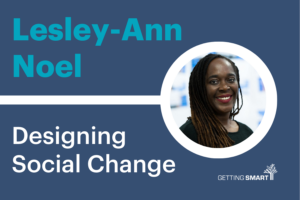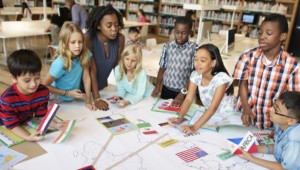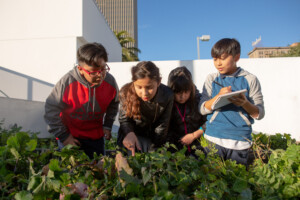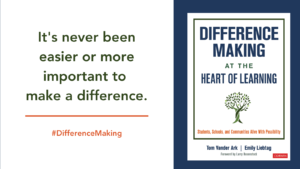The Power of Purpose-Based Learning

By: Terra Tarango
The odds are good that you haven’t used long division in ages. You’ve probably forgotten the periodic table and can’t recite all 50 state capitals. And it’s highly unlikely you entertain your colleagues at work by playing the recorder you worked so hard to learn in fourth grade. So how do you answer a student who raises a hand and asks, “When are we ever going to use this?”
Sure, you can come up with a rationale for why these things have value. But deep down, most of us suspect that those rationales are really just rationalizations. The truth is, we teach science primarily because you never know which one student in your class might go on to become a scientist and make the world a better place. But that value is uncertain and wildly distant—and therefore, not particularly persuasive to that one kid with their hand in the air asking you how your content is relevant to them. It’s time to change that.
What If There’s Another Way?
Let’s make learning relevant to our students by instilling it with purpose—not some distant, possible purpose, but purpose right now. And let’s do that in the most powerful way possible: by helping our students to positively impact the world. Today. What does that look like?
- Fourth graders learning how to disagree civilly, then sharing their voices with the world in a podcast.
- Elementary students learning about financial literacy, then teaching high schoolers to avoid debt, save wisely, and invest in their future.
- Teachers finding out what issues their students are passionate about, and then helping them take real and concrete steps to address those issues.
What About Content?
What about all those standards we need to address? Well, teachers around the country are discovering that these types of real-world projects provide the perfect foundation to naturally integrate content understanding. Let’s look at all the rich content that can be mined from a project where students form friendships with senior citizens in a retirement community, then craft biographies as mementos for their new friends.
Math: Have students create a “life timeline” of their senior friend, convert important time periods into fractions of that person’s life, and compare those divisions to benchmark fractions.
English and Language Arts: Use relevant literature such as “Wilfrid Gordon McDonald Partridge” by Mem Fox to explore the idea of theme. Then challenge students to discover not just the chronological events of their senior friend’s life, but to determine the theme of their life. Was it love of family? Overcoming obstacles? Have them write a biography using theme as the guiding structure.
Science: Partner students with seniors who were born in the same month that they were, then drive home the idea of celestial patterns by having students discover that although they were born decades apart, the night sky looked almost the same when they and their senior friend were born.
Social Studies: Have students consider similarities and differences between life today and life during the childhood of their senior friend.
And that’s just the beginning. If you keep an open mind, you can connect almost any content you need to teach to a meaningful, authentic learning experience. And the real magic of this approach is that the content, when you make it part of a meaningful experience, sticks with students. We learn best by applying what we’ve learned, and even more so by applying what we’ve learned to a relevant purpose. So, when teachers integrate their standards into work students care about, they’re discovering that they spend less time reteaching, and student test scores actually improve.
What About Skills?
But in today’s world, where content is essentially an easily accessed commodity, how do we ensure these projects are equipping students with the skills they need to be successful in the future workplace? Given that we are tasked with preparing students for jobs that don’t yet exist, I suggest we look toward the past first. Skills that drove society forward 100 years ago and are still relevant today are skills that are likely to still be relevant 100 years from now. Skills such as curiosity, creativity, critical thinking, collaboration, perseverance, and social-emotional awareness. Just think about how richly these skills can be developed with the senior citizen biography project.
Curiosity: Have students generate interview questions for their senior friend to learn about how they were affected by significant events in modern American history.
Creativity: Encourage students to publish each senior friend’s life story into an heirloom that visually represents their life and emotionally connects to the reader.
Critical thinking: Guide students in analyzing the facts they get from their senior friend, finding commonalities, and categorizing their life events into a coherent theme.
Collaboration: Group students in pairs to negotiate roles and collaborate in the development and publication of their senior friends’ biographies.
Perseverance: Build in time for multiple pen pal exchanges to build the relationship. Then have students get feedback on their initial drafts and make changes to solidify learning as an iterative process.
Social-Emotional Awareness: Have students discuss relationship skills and social awareness by using empathy in their interactions with a senior friend.
Why Me?
This kind of purpose-based learning isn’t the norm—yet. Right now, you’ll really stand out if you build your instruction by asking yourself, “What can my class do this month to make the world a better place?” You’ll be a blue apple in a tree full of red ones. But is that such a bad thing? If you envision a world where the educational system adequately prepares students for the world they will enter into, where content areas are integrated to promote deeper understanding, where students develop a lifelong love of learning in pursuit of doing good, then be that teacher who stands out. Discover how your students can change the world. Then let them.
What about you? How do you inspire purpose-based learning in your classrooms?
For more, see:
- One Stone: Where Purpose Meets Impact
- The Purposes of High Quality PBL
- Playing With Purpose: Using Games to Enrich Learning & Engage Students
Stay in-the-know with innovations in learning by signing up for the weekly Smart Update.
Terra Tarango is the founder of Blue Apple. Find her on Twitter at @TerraTarango.





0 Comments
Leave a Comment
Your email address will not be published. All fields are required.